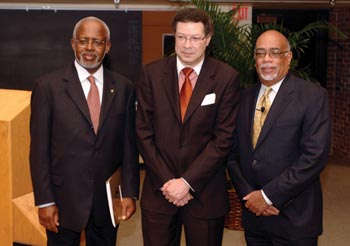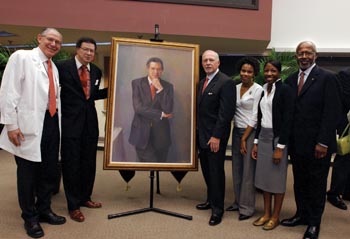
From left are George Hill, Ph.D., Levi Watkins Jr., M.D., and Howard University's Robert Taylor, M.D., Ph.D., who delivered the Fourth Annual Levi Watkins Jr. Lecture on Diversity in Medical Education.
Watkins Lecture stresses minority student ‘pipeline’

On hand for the unveiling of the portrait honoring Levi Watkins Jr., M.D., were, from left, VUSM Dean Steven Gabbe, M.D., Watkins, Harry Jacobson, M.D., vice chancellor for Health Affairs, VUSM students Rasheeda Stephens and Monica Giles, and George Hill, Ph.D., associate dean for Diversity in Medical Education. photo by Anne Rayner
Howard University's Robert Taylor, M.D., Ph.D., returned to Vanderbilt on Tuesday for the first time since 1979, stressing the need for a pipeline catering to minority students at a very young age.
Taylor, an African-American who completed his residency training in internal medicine at Vanderbilt University Hospital, delivered the Fourth Annual Levi Watkins Jr. Lecture on Diversity in Medical Education.
An academician, physician, clinical pharmacologist, researcher and administrator, he has been Howard University Hospital's director of the Division of Clinical Pharmacology since 1980 and was appointed interim dean of the university's College of Medicine in August 2005.
Speaking on demographics in the United States, Taylor noted that 50 percent of U.S. workers are anticipated to be persons of color by 2050. He also noted the United States is losing ground to other nations in areas including patents, published research and Nobel prizes.
“I think the biggest issue is developing an extensive pipeline of applicants all the way back down into elementary,” he said, noting that Howard has started its own middle school for math and science on campus.
“You have to start at that level. You can find a few [minorities] that get to college but then you have the competition of 125 medical students and they cannot compete like that.”
Taylor urged students to read “The Four Stages of Professional Careers,” a 1977 article that outlines apprentice, colleague, mentor and sponsor.
From a medical perspective, he sees a need for more strong black mentors, as blacks make up just 3,553 of the nation's medical school faculty as compared to 82,056 whites.
Taylor credited the elevate program as a way Vanderbilt is working to offset the trends in society.
“You have to have an institutional commitment to diversity. Vice Chancellor for Health Affairs Harry Jacobson, M.D., has done a great job of doing that and the fact that we have programs like the [Watkins Lecture] are really evidence of that,” Taylor said.
“I knew about Vanderbilt's commitment and that's why I came, I wanted to be a part of that and help them go further into the picture. They still have a lot of progress to make but I think they have come a long way.”
The lecture, presented by the Vanderbilt University School of Medicine's Office for Diversity in Medical Education, is named after the School of Medicine's first African-American student to be admitted and graduate from the program.
Watkins became the first African-American to be honored in Vanderbilt's oil painting collection, as his portrait from Cedric Egeli was unveiled during the ceremony.
Currently a professor of Cardiac Surgery and dean of postdoctoral programs at the Johns Hopkins School of Medicine, Watkins has seen many changes at Vanderbilt since he graduated in 1970.
“The medical school's enrollment has been a big area of change,” Watkins said. “Another area is leadership who are absolutely committed. I am talking about [Associate Dean for Diversity] Dr. George Hill, Dr. Jacobson and School of Medicine Dean Steve Gabbe, [M.D.]”
“They still have a lot of work to do on the faculty level but Vanderbilt has changed tremendously and I guarantee you there won't be many majority medical schools where there would be a portrait of a black man on their walls.”
Hill said the program was important for all students.
“It represented the efforts that this Medical Center is making to increase the diversity of the institution in many different ways and it shows a commitment to this effort,” Hill said.













